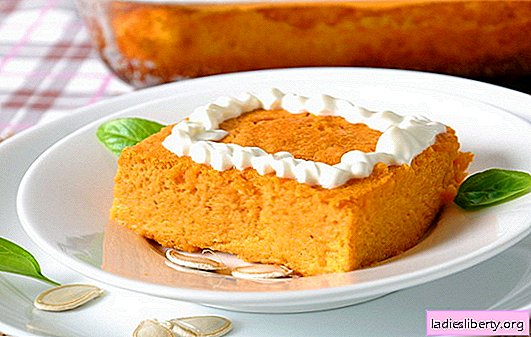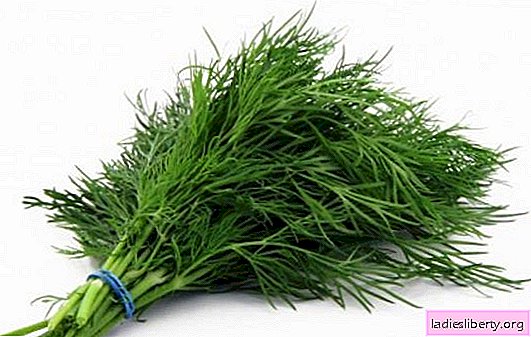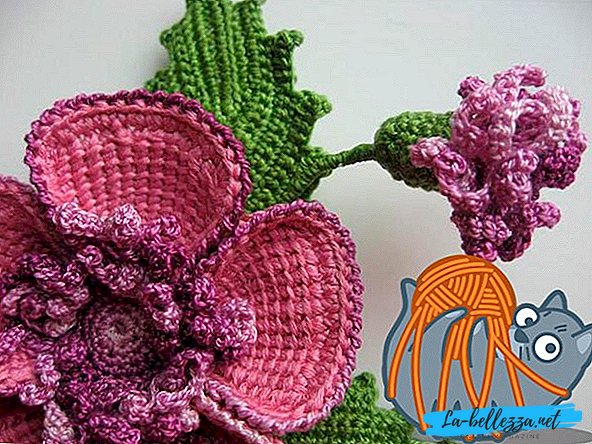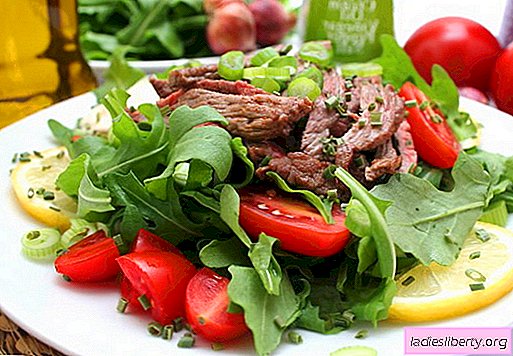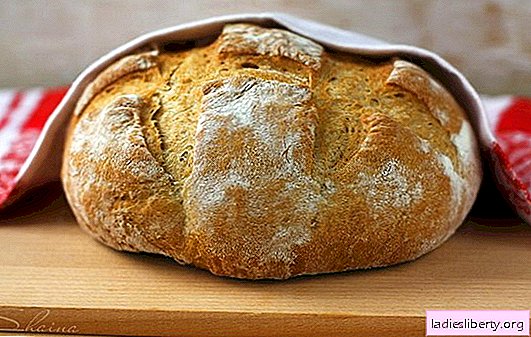
Rye bread is certainly one of the most interesting products in terms of taste and preparation.
It is very difficult to cook it and many professional chefs consider rye loaves a masterpiece among their pastries.
However, it’s worth a try.
If you carefully follow recipes, adhere to all the nuances of technology, the result promises to be truly impressive.
Freshly baked bread has magical properties - it rarely disappears from the table at such a speed, but if there is a hot loaf of rye flour, then, as a rule, there is not a crumb left.
Oven rye bread at home in the oven - the basic principles of cooking
• Technologies and recipes that allow you to bake fragrant "black" bread right in your own kitchen are not enough. The dough from rye flour is kneaded with yeast, kefir with and without yeast, on specially prepared sourdough or brewed.
• Combine all this diversity with two basic rules: the quality of flour and the exact observance of all the proportions indicated in the recipe.
• High-quality flour is always dry and soft. When such flour is compressed into a fist, the lump formed does not crumble immediately, but when you press the surface with your finger, the print pattern should remain on it.
• Before kneading the dough, flour is sifted without fail. Sifted flour bread turns out magnificent with uniform porosity.
• Home baked rye bread with the addition of wheat flour in strictly designated proportions according to the recipe, which is not desirable to change.
• Also, unless specifically stated in the recipe, do not change the temperature. Bake rye bread at home in the oven should be strictly following the instructions, this is due to different recipes for the dough, there is no universal rule here, be careful!
"Borodino" rye bread at home in the oven
Ingredients:
• 420 gr. rye flour;
• 50 ml non-aromatic, rast. oils;
• 150 ml of low-fat milk;
• 130 gr. white flour;
• “fast” yeast - 1.5 tsp;
• 1.25 liters of purified water;
• table. a spoonful of white sugar;
• one table. a spoonful of maltose syrup;
• three table. tablespoons of rye (red) malt;
• 10 g of fine, evaporated salt;
• coriander seeds - 3 tsp;
• dried caraway seeds.
Cooking method:
1. Crush and grind 2/3 of the aromatic seeds in a mortar. Then mix them with malt and, after pouring half a glass of slightly cooled boiling water, set aside for half an hour, insist and cool.
2. After that, immediately proceed with the preparation of the sponge. To do this, dissolve instant yeast in warm, but not hot milk. Add all the sugar at once, 2 full tablespoons of white flour and, stirring well, leave for a quarter of an hour.
3. In a wide bowl for kneading the dough, transfer on a fine sieve two types of flour: rye and white baking, mixing them in the process.
4. Add salt and stir evenly over the flour.
5. Then pour in the increased volume of dough, the cooled malt mass, molasses and, pouring the remaining water, heated to 38 degrees, knead the dough.
6. The dough should be soft and very sticky, so in the process the hands are slightly moistened with vegetable oil.
7. Cover the bowl with the dough with a cotton or linen towel and set aside in a warm place.
8. The readiness of the test for further processing is determined by double the volume, or even a little more. Lightly knead the dough and, dividing into portions, lay out on the forms prepared for baking.
9. Turn on the oven and slightly warm it (up to 30 degrees), remove the molds with the dough for half an hour for the second proofing.
10. Then grease the surface of the approached bread with warm, in no case cold water, sprinkle with the remaining seeds.
11. Bake such bread first a quarter of an hour at 200 degrees, then twenty-five minutes at 180 and at the end of 19 minutes, at 160 degrees.
Oven custard at home in the oven
Ingredients:
• 30 grams of ordinary bread yeast;
• 200 gr. coarse rye flour;
• sugar refined - 2 tbsp. l .;
• 350 grams of baking flour;
• Extra evaporated salt - 10 g;
• good rye (dry) malt - 2 tbsp. spoons.
Cooking method:
1. Mix white flour (150 gr.) With malt and pour the mixture with three hundred milliliters of boiling water.
2. When pouring boiling water, stir the mass well with a fork so that there are no lumps.
3. In a separate bowl, dissolve the yeast in 270 ml of a little warm water. Stirring until completely dissolved, add sugar and salt.
4. Combine the flour and dissolved yeast with malt and stir until smooth. The result is a liquid flour mass of dark brown color.
5. Pour all the remaining flour into the liquid flour mass and knead a dough that does not stick to your hands.
6. Cover the container with the dough with a cloth towel and leave for three and a half hours.
7. Turn on the oven, on the bottom shelf, install a metal saucer with water, and heat to 220 degrees.
8. Wash the dough that has increased in volume with your hands, sprinkle with flour and transfer it to the baking dish. Cover with a towel and leave again for 20-25 minutes.
9. When the dough comes up, put the roasting pan in the oven and bake for 45 minutes.
10. Then remove the mold and remove the loaf from it, wrap it in a towel and leave it for three hours, during which time the loaf will “ripen”.
Oven recipe for baking rye bread at home in the oven
Sourdough prepared according to this recipe can be used not only for baking rye bread, but you can also make good homemade kvass on it.
Ingredients:
• ten tbsp. tablespoons of coarse rye flour;
• 10 grams of sugar;
• two hundred gram glass of water.
Cooking method:
1. Part of the flour (full four tablespoons), dilute one hundred milliliters of cold water, achieving a consistency with a similar thick sour cream.
2. Pour granulated sugar, several times, stir with small breaks and cover with a cloth, leave for a day.
3. At the end of time, add another 2 tablespoons of flour and dilute with water to the previous density. Leave for another day under a napkin.
4. Please note that the sourdough should not be thick, so when adding flour, always dilute it to the density of sour cream with cold boiled water.
5. On the third day, the leaven acquires the characteristic smell of sour bread, this is normal, this is the result that is needed.
6. Add flour again, dilute with water if necessary and leave again for a day. Fully leaven will be ready on the fourth day.
7. Add flour and water again, stir. Take the necessary amount for making bread, and tightly close the remaining part, put in storage in the refrigerator.
8. The starter starch must be “fed” with flour once a week, otherwise it will “die”.
Rye bread at home in a leaven oven
Ingredients:
• purified water, boiled, chilled - 300 ml;
• frozen sunflower oil;
• 4 cups of rye (peeled) flour;
• 300 ml of yeast according to the above recipe;
• a small pinch of coriander;
• 10 g of salt;
• 50 grams of white granulated sugar;
• good malt (replaceable with dry rye kvass) - 2 tbsp. spoons;
• 60 gr. sunflower seeds (without husk).
Cooking method:
1. Combine half of the rye flour specified in the recipe with the sourdough and chilled boiled water. Stir so that there are no lumps, and leave for 5 hours to come. In the process, the dough will increase approximately three times.
2. Brew malt or kvass in 90 ml of boiling water, cool and add the dough that has come to this time.
3. Pour in spices, sugar and salt, pour in butter and knead the dough.
4. Transfer it to oiled forms and leave, covering the top of the forms with a cotton or linen cloth (towels), for a distance of 3 hours. Filling out the forms with dough is recommended by one third.
5. Sprinkle the approached dough with peeled seeds and place in a warm oven to bake.
6. Bake from 45 minutes to an hour, at 180 degrees. Duration depends on the size of the resulting loaf.
Oven rye bread at home in the oven, kefir and yeast
Ingredients:
• 150 gr. white and 250 gr. rye, coarse flour;
• refined, non-aromatic oil - 1 tbsp. l
• 200 ml yogurt, or sour kefir, low-calorie;
• 1 tsp dry yeast;
• cage salt and granulated sugar - 1 tsp each.
Cooking method:
1. Sour milk products in advance to warm the room temperature.
2. Then mix with 150 ml of boiled water heated to thirty degrees and dissolve salt and granulated sugar in the resulting mixture.
3. In a mixing bowl, transfer the rye and baking wheat flour, gradually add the yeast and mix well, evenly stirring the yeast over the flour.
4. Make a small depression and, gradually pouring in the fermented milk mixture, knead the dough. If during kneading, you feel that it turns out to be excessively tight, add a little water.
5. Properly kneaded dough is elastic, smooth and soft.
6. Cover the dishes with the dough with a cloth and put on a "rest" for half an hour.
7. Pour oil gradually and evenly, and crush with your hands until completely absorbed.
8. Then transfer the dough into a slightly warmed form and leave, covering with a towel for "proofing" for two hours.
9. Sprinkle the table with white flour, put on it the approached (noticeably by doubling the volume) dough, and form a loaf of round shape from it.
10. Transfer it to parchment in a roasting pan and leave, covering with a towel, for half an hour, for the final "proofing".
11. Bake at 200 degrees for about forty minutes.
12. Before installing the baking sheet with the dough in the oven, sprinkle liberally its walls with water.
Fast, yeast-free, rye bread at home in the oven on a kefir
Ingredients:
• yogurt from "factory" milk, or medium fat kefir - 200 ml;
• wheat white flour - two glasses;
• one glass of “coarse” rye flour;
• 0.5 tsp food soda;
• a little mixture of fragrant "Provence" herbs;
• evaporated salt - 5 g;
• 1 tsp refined sugar.
Cooking method:
1. Slightly heated kefir (yogurt) mix with soda and leave for a quarter of an hour on the table. You should not do this on a stove or in a microwave oven, preferably on a battery or by placing a container with sour milk in warm water.
2. Then mix salt, granulated sugar and a mixture of Provencal herbs in a separate bowl. Pour in increased yogurt and knead the dough, adding the sifted flour very slowly.
3. We take the whole portion of rye flour, and wheat should first take one glass and then with kneading to adjust the density of the dough. It should be fairly soft and non-fluid.
4. Cover the pan or roasting pan with parchment, put the kneaded dough into it and set it to "rest" for a quarter of an hour, covering it with a towel. It is advisable to do this on a warm battery or on top of the stove, while turning on the oven for heating.
5. After, make a longitudinal incision and a few more across the future loaf and put the form with the dough in a preheated oven.
6. Bake the bread for half an hour to forty-five minutes, then turn off the heating of the oven and leave the bread with the door closed for another fifteen minutes.
7. Remove the baked bread from the oven and wrap until completely cooled in a towel.
"Karelian" rye bread at home in the oven
Ingredients:
• 100 grams of flour, rye;
• a mixture of anise with caraway seeds and coriander, about 8 g;
• 50 grams of malt;
• 300 ml of water (infused);
• baking flour - 650 grams;
• 10 grams of fresh (bread), or 5 grams of "dry" yeast;
• 250 ml of water (in a dough);
• 50 grams of a mixture of raisins and dried apricots;
• 45 grams of honey;
• 1.5 tsp evaporated (shallow) salt;
• 200 ml of water (per dough);
• 80 grams of molasses.
Cooking method:
1. First, prepare the tea leaves for the dough. Grind in a seasoning mortar. Add all the rye flour, water and mix well, heat with minimal heat, and best of all in a water bath up to 70 degrees. Then cover the container with tea leaves and place it for two hours in an oven preheated to 70 degrees. The finished tea leaves will look like melted chocolate.
2. Next, prepare the dough. Dilute the tea leaves with a glass of cold water. Add the yeast, stir to dissolve it, and add the whole portion of the wheat flour. After finally stirring everything, let it stand and approach the dough for four hours.
3. Before kneading the dough, soak pitted raisins and dried apricots in boiling water for ten minutes. Drain the water, and dry the dried fruits well, chop with a heavy sharp knife, about 5 mm pieces and roll in white wheat flour.
4. In boiling water, dissolve honey, molasses, salt and, slightly cooling, add the mixture to a suitable dough.
5. Gradually add wheat baking flour, knead a dough, elastic dough. At the end of kneading, add prepared dried fruits. Let the dough come up.
6. After two hours, move the dough onto the table and press down a little with your hands to make a pancake. Then roll it into a tight roll, pinching the edges with each turn.
7. Transfer the dough into a mold or simply on a baking sheet, on parchment, to proof for one hour.
8. After the dough has risen and become a little softer, bake the loaves at 180 degrees. Time - 1 hour.
Oven bread at home in the oven - tricks and tips
• Do not overdo the dough during proofing, otherwise it will break during baking, and tears will appear on the surface of the baked bread.
• The softer the dough, the more porous the structure of the bread itself.
• To make the bread rise evenly during baking, stick the pasta in several places in the dough.
• Rye bread is better baked if there is a container of water in the oven. Also, before putting the roasting pan with the dough, the oven walls are abundantly sprayed with water.
• When mixing the dough, the recommended proportions must be strictly observed. The crumb of rye bread baked from too thin dough turns out to be sticky and too wet. From thick - too dense and quickly stale.
• Cutting hot rye bread is not recommended. Before cooling, the crumb ripens.
• "Karelian" bread is very loved by children, you can experiment with the recipe to please your little rascals. So, raisins with dried apricots are well replaced by candied citrus fruits, unless it is worth slightly reducing their number. Just delicious rye bread with the addition of small pieces of hard marmalade.
• If you have a baking talent, try baking bread from two different types of dough at once - rye and wheat. A loaf is formed by folding into a roll two flat pieces of different colors. Such bread is also very tasty with the addition of raisins, marmalade, fried nuts, or sunflower seeds.


